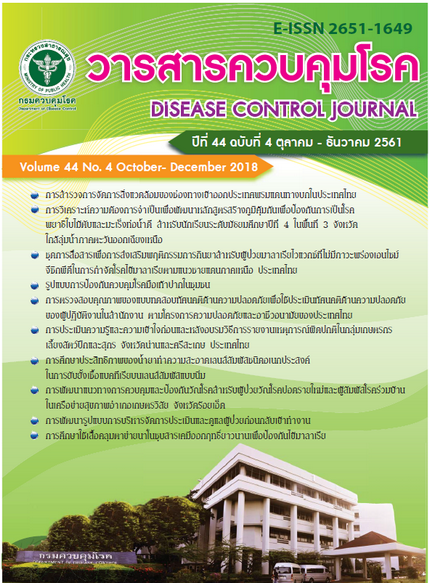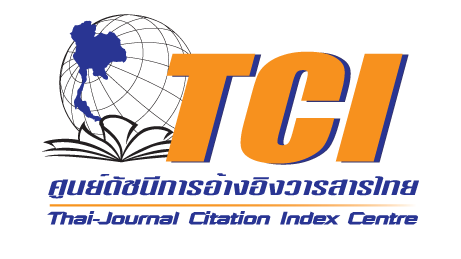การศึกษาประสิทธิภาพของน้ำยาทำความสะอาดเลนส์สัมผัสชนิดอเนกประสงค์ ในการยับยั้งเชื้อแบคทีเรียบนเลนส์สัมผัสแบบนิ่ม
DOI:
https://doi.org/10.14456/dcj.2018.37คำสำคัญ:
น้ำยาทำความสะอาดเลนส์สัมผัสชนิดอเนกประสงค์, แบคทีเรีย, เลนส์สัมผัสแบบนิ่มบทคัดย่อ
เลนส์สัมผัส (contact lens) เป็นเครื่องมือแพทย์สำหรับแก้ไขปัญหาสายตาที่ได้รับความนิยมในปัจจุบัน อย่างไรก็ตาม มักพบการปนเปื้อนและการติดเชื้อจากจุลชีพที่ตาจากการใช้งานดังกล่าว ปัจจุบันจึงมีน้ำยาทำความสะอาดเลนส์สัมผัสมากมายหลายชนิด คณะผู้วิจัยจึงเห็นความสำคัญในการศึกษาประสิทธิภาพของน้ำยาทำความสะอาดเลนส์สัมผัสชนิดอเนกประสงค์ (multipurpose solutions) ในการยับยั้งเชื้อแบคทีเรียบนเลนส์สัมผัสแบบนิ่ม โดยการศึกษาครั้งนี้ทำการศึกษาการยับยั้งเชื้อ Pseudomonas aeruginosa ATCC 27853 และ Staphylococcus aureus ATCC 25923 โดยได้ทดสอบประสิทธิภาพของน้ำยาทำความสะอาดเลนส์สัมผัส เปรียบเทียบกันใน 3 เครื่องหมาย ได้แก่ น้ำยา A และ C ซึ่งมีส่วนประกอบเหมือนกัน (boric acid, polidronium chloride 0.001%, myristamidopropyl dimethylamine 0.0005%) และน้ำยา B (boric acid, sodium borate, polyaminopropyl biguanide 0.00013%, polyquaternium 0.0001%) ผลการศึกษาพบว่า ปริมาณเชื้อที่ความเข้มข้น 1.5x106 CFU/ml เป็นความเข้มข้นที่เลือกใช้ในการจำลองการปนเปื้อนเชื้อแบคทีเรียบนเลนส์สัมผัส สำหรับการทดสอบประสิทธิภาพน้ำยาทำความสะอาดเลนส์สัมผัสทั้ง 3 เครื่องหมายการค้า มีประสิทธิภาพในการยับยั้งเชื้อทั้ง 2 ชนิด ตามข้อบ่งใช้ที่ระบุในเอกสารกำกับยา การเปรียบเทียบประสิทธิภาพของน้ำยาทำความสะอาดเลนส์สัมผัสชนิดอเนกประสงค์ในการยับยั้งเชื้อแบคทีเรียบนเลนส์สัมผัสแบบนิ่มที่อุณหภูมิและเวลาต่าง ๆ พบว่า น้ำยาทั้ง 3 เครื่องหมายการค้า สามารถยับยั้งเชื้อ S. aureus ATCC 25923 ได้ที่อุณหภูมิ 6±2°C 25±2°C และ 35±2°C ตั้งแต่เวลา 2 ชั่วโมง ถึง 28 วัน สำหรับเชื้อ P. aeruginosa ATCC 27853 น้ำยาเครื่องหมายการค้า A และ C สามารถยับยั้งได้ทั้ง 3 อุณหภูมิ ตั้งแต่เวลา 2 ชั่วโมง ถึง 28 วัน น้ำยาเครื่องหมายการค้า B สามารถยับยั้งเชื้อ P. aeruginosa ATCC 27853 ได้ดีที่อุณหภูมิ 25 ± 2˚C ตั้งแต่เวลา 2 ชั่วโมง ถึง 28 วัน แต่ที่อุณหภูมิ 6±2˚C และ 35±2˚C ยังพบเชื้อ P. aeruginosa ATCC 27853 ที่ปริมาณใกล้เคียงกับการทดลองควบคุมที่เวลา 0-24 และ 0-4 ชั่วโมง ตามลำดับ สรุปผลการศึกษานี้สามารถเป็นแนวทางในการทำความสะอาดเลนส์สัมผัส เพื่อป้องกันการเกิดการติดเชื้อแบคทีเรีย ซึ่งอาจก่อให้เกิดอันตรายต่อดวงตาของผู้ใช้เลนส์สัมผัสได้
Downloads
References
2. Morgan PB, Woods CA, Tranoudis IG, Helland M, Efron N, Jones L, et al. International contact lens prescribing in 2016 Our 16th report in contact lens spectrum outlines the latest trends in contact lens prescribing around the world. Cont Lens Spec 2017;32:30-5.
3. Dart JKG, Stapleton F, Minassian D. Contact lenses and other risk factors in microbial keratitis. Lancet 1991;338:650-3.
4. Brennan NA, Coles ML. Extended wear in perspective. Optom Vis Sci 1997;74:609-23.
5. Morgan PB. Contact lens compliance and reducing the risk of keratitis. Optician 2007;234:20-5.
6. Alfonso E, Mandelbaum S, Fox MJ, Forster RK. Ulcerative keratitis associated with contact lens wear. Am J Ophthalmol 1986;101:429-33.
7. Szczotka FLB, Imamura Y, Chandra JYC, Mukherjee PK, Pearlman E, Ghannoum MA. Increased resistance of contact lens related bacterial biofilms to antimicrobial activity of soft contact lens care solutions. Cornea 2009;28:918-26.
8. Lin L, Kim J, Chen H, Kowalski R, Nizet V. Component analysis of multipurpose contact lens solutions to enhance activity against Pseudomonas aeruginosa and Staphylococcus aureus. Antimicrob Agents Chemother 2016;60:4259-63.
9. Schultz CL, Pezzutti MR, Silor D, White R. Bacterial adhesion measurements on soft contact lenses using a Modified Vortex Device and a Modified Robbins Device. J Ind Microbiol 1995;15: 243-7.
10. Aswad MI, John T, Barza M, Kenyon K, Baum J. Bacterial adherence to extended wear soft contact lenses. Ophthalmology 1990;97:296-302.
11. Meers PD, Chow CK. Bacteriostatic and bactericidal actions of boric acid against bacteria and fungi commonly found in urine. J Clin Pathol 1990;43:484-7.
12. Codling CE, Hann AC, Maillard JY, Russell AD. An investigation into the antimicrobial mechanisms of action of two contact lens biocides using electron microscopy. Cont Lens Anterior Eye 2005;28:163-8.
13. Kamaruzzaman NF, Firdessa R, Good L. Bactericidal effects of polyhexamethylene biguanide against intracellular Staphylococcus aureus EMRSA-15 and USA 300. J Antimicrob Chemother 2016;71:1252-9.
14. Ling ML, Ching P, Widitaputra A, Stewart A, Sirijindadirat N, Thu LTA. APSIC guidelines for disinfection and sterilization of instruments in health care facilities. Antimicrob Resist Infect Control 2018;7:25.
Downloads
เผยแพร่แล้ว
How to Cite
ฉบับ
บท
License
บทความที่ลงพิมพ์ในวารสารควบคุมโรค ถือว่าเป็นผลงานทางวิชาการหรือการวิจัย และวิเคราะห์ตลอดจนเป็นความเห็นส่วนตัวของผู้เขียน ไม่ใช่ความเห็นของกรมควบคุมโรค ประเทศไทย หรือกองบรรณาธิการแต่ประการใด ผู้เขียนจำต้องรับผิดชอบต่อบทความของตน


.png)



